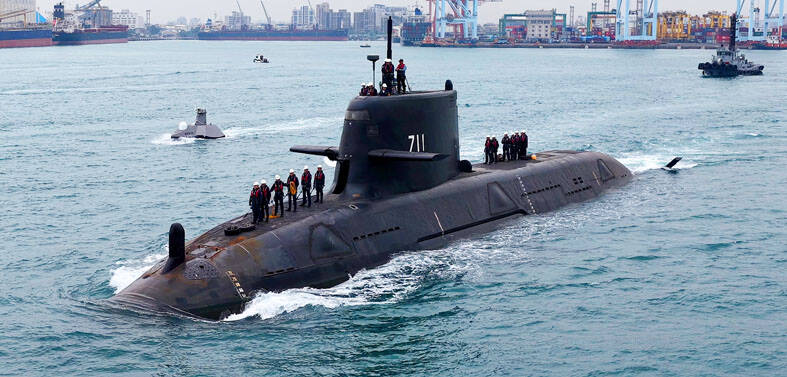Changing the national emblem should not be taken lightly, as it embodies the nation’s collective sentiment, but political party symbols can and should change with the times, the Ministry of the Interior said on Thursday in a report on the issues stemming from similarities between the national and Chinese Nationalist Party (KMT) emblems.
The ministry issued the report in response to a motion raised by the New Power Party caucus and passed on Jan. 29 requesting an evaluation within two months.
Since its installment in 1928, the national emblem has been broadly applied on the national and military flags, medals, uniforms, certificates, foreign embassies and other places, it said.

Photo: Chen Yu-fu, Taipei Times
Changing the emblem would involve difficult legal amendments and considerable expense to redesign all of the aforementioned applications, it said.
The ideological strife it would exacerbate is also a concern, potentially spilling over into the nation’s international dealings, the report added.
The nation went through a long period of authoritarian rule that erased the lines between party and state, but has been lauded the world over for its transition to democracy, earning it the moniker “the beacon of democracy in Asia,” it said.
Although the similarity between the national and KMT emblems is based in history, the national emblem is a symbol of the nation and changing it should not be considered lightly, the ministry said.
On the other hand, the symbols of political parties can and should change to reflect current sentiment, it said.
The party-state era is over and the political arena has become diversified, so political symbols should change to respect the national emblem, it added.
In response, KMT Chairman Johnny Chiang (江啟臣) wrote on Facebook that the suggestion was a deliberate attempt by the Democratic Progressive Party (DPP) to shift the public’s focus from the deadly train accident in Hualien County on Friday last week, claiming the lives of 50 people and injuring more than 200 others.
Taking up the issue is a scheme on the DPP’s part to shift the public’s attention from the tragedy and to dodge its responsibility, which is a disgrace to those who perished in the accident and their families, Chiang said.
He also questioned the DPP’s loyalty to the nation, its flag and the national emblem.
“If the DPP fully identifies with the Republic of China, the KMT will be happy to see it incorporate elements of the national flag and national emblem into its party emblem,” he said.
Deputy Minister of the Interior Chen Tsung-yen (陳宗彥) yesterday said the report only offers an analysis of the current situation and is not a demand for any political party to change their party emblem.

US climber Alex Honnold is to attempt to scale Taipei 101 without a rope and harness in a live Netflix special on Jan. 24, the streaming platform announced on Wednesday. Accounting for the time difference, the two-hour broadcast of Honnold’s climb, called Skyscraper Live, is to air on Jan. 23 in the US, Netflix said in a statement. Honnold, 40, was the first person ever to free solo climb the 900m El Capitan rock formation in Yosemite National Park — a feat that was recorded and later made into the 2018 documentary film Free Solo. Netflix previewed Skyscraper Live in October, after videos

NUMBERS IMBALANCE: More than 4 million Taiwanese have visited China this year, while only about half a million Chinese have visited here Beijing has yet to respond to Taiwan’s requests for negotiation over matters related to the recovery of cross-strait tourism, the Tourism Administration said yesterday. Taiwan’s tourism authority issued the statement after Chinese-language daily the China Times reported yesterday that the government’s policy of banning group tours to China does not stop Taiwanese from visiting the country. As of October, more than 4.2 million had traveled to China this year, exceeding last year. Beijing estimated the number of Taiwanese tourists in China could reach 4.5 million this year. By contrast, only 500,000 Chinese tourists are expected in Taiwan, the report said. The report

Temperatures are forecast to drop steadily as a continental cold air mass moves across Taiwan, with some areas also likely to see heavy rainfall, the Central Weather Administration (CWA) said. From today through early tomorrow, a cold air mass would keep temperatures low across central and northern Taiwan, and the eastern half of Taiwan proper, with isolated brief showers forecast along Keelung’s north coast, Taipei and New Taipei City’s mountainous areas and eastern Taiwan, it said. Lows of 11°C to 15°C are forecast in central and northern Taiwan, Yilan County, and the outlying Kinmen and Lienchiang (Matsu) counties, and 14°C to 17°C

STEERING FAILURE: The first boat of its class is experiencing teething issues as it readies for acceptance by the navy, according to a recent story about rudder failure The Hai Kun (海鯤), the nation’s first locally built submarine, allegedly suffered a total failure of stern hydraulic systems during the second round of sea acceptance trials on June 26, and sailors were forced to manually operate the X-rudder to turn the submarine and return to port, news Web site Mirror Daily reported yesterday. The report said that tugboats following the Hai Kun assisted the submarine in avoiding collisions with other ships due to the X-rudder malfunctioning. At the time of the report, the submarine had completed its trials and was scheduled to begin diving and surfacing tests in shallow areas. The X-rudder,